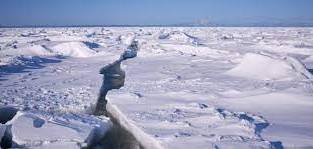
The Arctic has long been portrayed as a distant place, on the edge of the Earth, disconnected from common everyday experience. But as the planet heats up quickly, everything that happens in this icy region, where temperatures are rising twice as fast as the rest of the world , affecting more and more lives worldwide whole.
The Arctic has been the subject of a strong revival of interest since the beginning of the 2000s. resources) and contributing to the increase in human activity. It also constitutes a new theater of assertion of power for riparian States or outside the zone.
December 14, 2021, a team of 111 scientists from 12 countries published the 16th Annual Bulletin Arctic .In the report, are examined so diverse the physical, ecological and human interconnected from this region so fragile.
As an annual review with a doctor, the report assesses the Arctic vital signs - including the temperature of the air surface temperature surface of the sea, sea ice , the snow cover, the Greenland ice sheet, the greening of the tundra and the rate of photosynthesis by oceanic algae - while s 'asking about other health indicators and emerging factors that shed light on the trajectory of arctic changes.
As the report describes, rapid and pronounced human-caused warming continues to drive most of the change and ultimately paves the way for disruptions that affect ecosystems and communities around the world.
Continuous ice loss
The Arctic sea ice - a key vital sign and one of the most iconic indicators of global climate change - continues to shrink under the effect of warming temperatures.
Including the 2021 data, 15 of the lower stretches of summer sea ice, that is to say, when the ice is at its minimum threshold for the year - all occurred in the last 15 years , a record dating from 1979 when satellites began to monitor regularly the region.
Sea ice is also thinning at an alarming rate as the oldest and thickest multi-year ice in the Arctic disappears. This loss of sea ice decreases the capacity of the Arctic to cool the global climate. It can also change the weather systems at low latitudes in proportions that make it more likely previously rare weather events and milestones, such as droughts, heat waves and extreme winter storms.
Similarly, the continued melting of the Greenland ice sheet and other land ice raises the sea levels worldwide, exacerbating the severity and exposure to coastal flooding, systems disruptions of drinking water and wastewater and coastal erosion for a much higher number of communities across the planet.
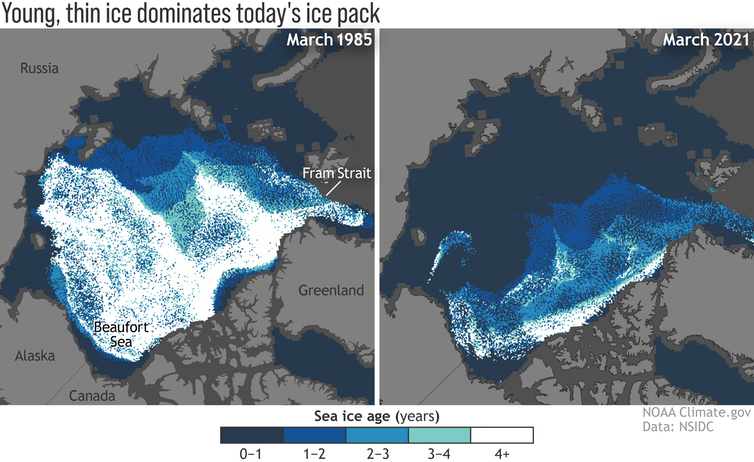
NOAA Climate.gov/NSIDC
A warmer and wetter Arctic
This ice-to-water transition and its effects are evident throughout the arctic system.
The eight major Arctic rivers now pour more fresh water in the Arctic Ocean, which implies an increase of the water from the earth to the Arctic because of scale precipitation, thawing permafrost and melting ice. Even more disturbing, the summit of the Greenland ice sheet - more than 10,000 feet above sea level - had its first rainfall recorded during summer 2021.
Permafrost: Permafrost, sometimes referred to as permafrost, is the part of a cryosol that is permanently frozen, at least for two years, and therefore impermeable. Permafrost exists in high latitudes but also in high altitudes.
These developments indicate a modified and more unstable Arctic today. They also give credit to new modeling studies that show the Arctic transition potential of a system dominated by the snow in a system dominated by rain in summer and autumn when the temperatures worlds reach only 1.5 degrees Celisus (2.7 F) above pre-industrial times. The world has already warmed 1.2 ° C (2.2 ° F).
Such a shift to more rain and less snow would undoubtedly reshape the landscapes more, fueling a faster retreat of glaciers and loss of permafrost. Thawing of permafrost affects not only ecosystems, but also adds to global warming by allowing plant and animal remains frozen before decomposing, releasing additional greenhouse gases into the atmosphere.
This year's report highlights how retreating glaciers and deteriorating permafrost are also increasing threats to human life due to sudden and localized floods and landslides. It urges for international coordinated efforts to identify these hazards. More rain in the Arctic will increase these threats even more.
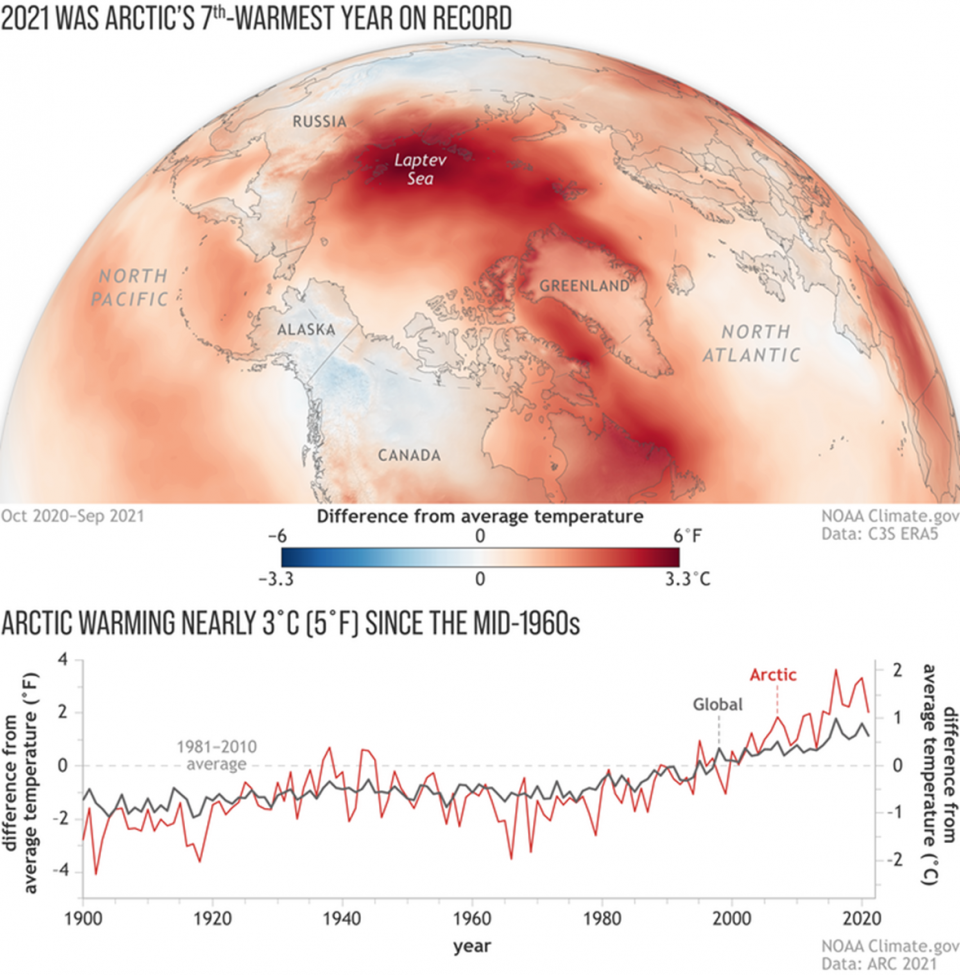 NOAA Climate.gov/CS ERA5
NOAA Climate.gov/CS ERA5
Growing human impact
The changes and disturbances observed in the Arctic are impacting daily life and actions around the world, either directly or in the form of stern reminders of human damage to climate and ecosystems.
A test of the Arctic report card on the beavers that extend northward into the Arctic tundra to exploit new favorable conditions is a case study. She studies how species around the world move as habitats respond to climate change and the need for new forms of collaborative monitoring to assess the magnitude of resulting ecological transformations.
An essay on marine litter from the expedition failed to land on the coast of the Bering Sea , posing an immediate threat to food security in the region, reminds us that the threat of micro- and macro- plastics in our oceans is a crucial challenge of our time .
A report on the noise of the navigation seeping increasingly in the Arctic underwater soundscape , to the detriment of marine mammals, is a call to protect the integrity of soundscapes natural products all over the world. For example, a recent study has revealed that the noise caused by human activities and biodiversity loss deteriorates soundscapes birds singing spring in North America and Europe.
Yet a study by Network members indigenous foods on knowledge highlights how, despite the constant climatic threats to the Arctic food systems, indigenous communities in Alaska have overcome food disruptions caused by the pandemic through their cultural values of sharing and their systematic “community first” approaches.
Their cooperation and adaptability offers an important lesson for struggling communities around the world, while reminding everyone that the Arctic itself is a homeland; a place where large-scale disruption is nothing new to its more than 1 million indigenous peoples, and where solutions have long been found in reciprocal practices.
An Arctic connect ed to the world
The Arctic Bulletin compiles observations from across the circumpolar north, analyzing them in a polar projection of our planet. This puts the Arctic at the center, with all meridians extending outward to the rest of the world.
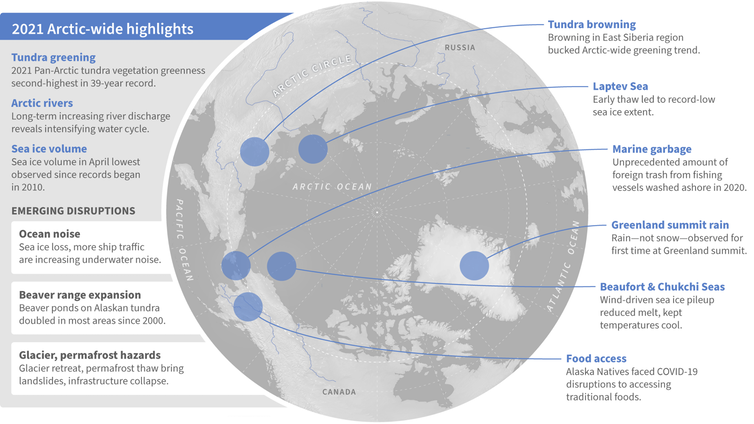
Some of the 2021 Arctic events were covered in the Arctic Report Card Climate.gov noAA
From this perspective, the Arctic is linked to societies around the world through a myriad of exchanges - the natural circulation of air, oceans and contaminants, the migration of animals and invasive species, as well as the human transport of people, pollution, goods and natural resources. The Arctic warming also allows a better marine access, because the loss of sea ice allows ships to sink deeper into the Arctic waters and for longer periods.
These realities highlight the importance of increased international cooperation in conservation, risk mitigation and scientific research.
The Arctic has already experienced unprecedented rapid environmental and social changes. A warmer, more accessible Arctic just translates into a world where we will find ourselves more closely connected to each other.
Sources
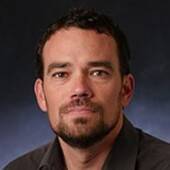 Matthew Druckenmiller Research Scientist, National Snow and Ice Data Center (NSIDC), Cooperative Institute for Research in Environmental Sciences (CIRES), University of Colorado at Boulder
Matthew Druckenmiller Research Scientist, National Snow and Ice Data Center (NSIDC), Cooperative Institute for Research in Environmental Sciences (CIRES), University of Colorado at Boulder Rick thoman
Rick thoman
Specialist climate of Alaska, University of Alaska Fairbanks
Deputy Principal Scientist, National Snow and Ice Data Center (NSIDC), Cooperative Institute for Research in Environmental Sciences (CIRES), University of Colorado at Boulder
Posted on 2021-12-15 20:04





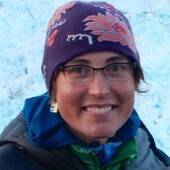



Comments